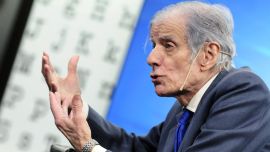Rex Tillerson devoted last week to a five-country Latin American swing: Mexico, Argentina, Peru, Colombia and Jamaica. About time too: after a year in charge and 18 foreign trips around the globe, this was his second time south of the Rio Grande, the first being his visit to Mexico City in February, 2017. Which gives us some idea as to how much priority the Donald Trump administration is assigning to its backyard, Latin America.
The US secretary of state’s tour had its own special timing. Hours before Tillerson boarded Air Force Two, Trump tweeted a direct reference to drug-producing countries causing deaths in the United States. Was he talking about Mexico? Or Colombia? Or perhaps Peru? Or Argentina? Or was he recalling Bob Marley in Jamaica? This violent innuendo was countered during the tour by Tillerson himself, who admitted that the US was the planet’s leading drug consumer with 65,000 deaths a year from overdosing, a serious problem indeed.
The start of Tillerson’s tour also coincided with the resignation of Tom Shannon, the under secretary of state for political affairs (and hence the US State Department’s third-in-command), a veteran of the Western Hemisphere and a ‘dove’ who constantly sought dialogue with Venezuela. The commentary in Washington was that this former top diplomat at both the US State Department and the National Security Council under former US president George W. Bush, ambassador to Brazil (2005-2009) and Barack Obama’s ex-sherpa in 2015 to Nicolás Maduro, resigned from moral exhaustion after Donald Trump’s outbursts against the State Department and the downsizing which had been entrusted to the former Exxon CEO. Rumour has it that Shannon was the last high-ranked expert in Latin American affairs left in the State Department.
Latin America has not been entirely orphaned by the exit of Shannon and his soft power, however. They say in DC nowadays that the eagle now flying over the region is White House Chiefof-Staff John Kelly, a retired four-star marine general who knows the darkest side of the region pretty well after spending three years as head of the US Southern Command. Depicted by one of his colleagues at SouthCom as “more of a warrior than a global strategist,” Kelly fought against illegal immigration and drug cartels, oversaw the Guantánamo base and both advised on and acted during the peace deal with FARC guerrillas in Colombia.
So who, allegedly, drew up the script and itinerary for Rex Tillerson’s five-nation tour? Has there been a shift in addressing the hemisphere’s affairs? If any, one route could have seen Rex visit the countries sensitive to narcotics (all five). Another, visiting and thanking four (Argentina, Mexico, Jamaica and Colombia) of the 35 nations which voted helpfully to abstain visà-vis Washington’s interests at the United Nations on the issue of Jerusalem as Israel’s capital. Peru is the odd one out here, having voted against the US proposal, yet the country is crucial to Washington, not only because it has a conservative administration with a feeble president struggling to survive (an ally the US cannot lose), but also because is is one of 2018’s non-permanent members in the decisive Security Council at the UN, besides being the host for the Summit of the Americas in April. A third template, more visible, was revealed on February 1 by Secretary Tillerson in Austin, Texas. It can be labelled “China, the US adversary,” since Beijing is the largest trading partner of Chile, Argentina, Brazil and Peru.
“Today, China is gaining a foothold in Latin America; it is using economic statecraft to pull the region into its orbit,” Tillerson said during a speech at his alma mater, adding that it “offers the appearance of an attractive path to development, but in reality, this often involves trading short-term gains for long-term dependency.”
He wrapped up with “Latin America does not need new imperial powers that seek only to benefit their own people; China’s state-led model of development is reminiscent of the past; it doesn’t have to be this hemisphere’s future.”
The question is if this wake-up call from Washington has come in time. Of the free-trade agreements the US has with 20 countries, 12 of them involve Latin American nations. The annual trade index with the region totals up to almost US$2 trillion worth of goods and services, with a US$14 billion trade surplus with the hemisphere. So it is really “America First” as regards trade.
Yet another question is whether China holds the Latin American sceptre in both trade and infrastructure investment terms. Is the US prepared to take over the Celestial Empire in those areas or were Tillerson’s remarks a mere warning, without any substitute plan to back it up? Well, Rex is a Texan, and the former head of Exxon, so he thinks in terms of energy. “By 2040, North America is expected to add more oil production to the global markets than the entire rest of the world combined and more gas production than any other single region,” Tillerson said in his Austin speech (without departing from the America First guidelines).
“Some 36 percent of US liquefied natural gas exports since 2016 have landed in Latin America” (more than any other region in the world), and it is expected that by 2030, the hemisphere will have spent at least US$70 billion on new electric power generation plants to fuel economic growth.
“Many of those plants will be powered by natural gas,” with the US as a “substantive and reliable supplier,” added the secretary of state turned salesman, in a very Trump-like tone.
Roadshow or not, the first Latin American swing of Trump’s secretary of state had, as its explicit objective, political cohesion in the face of adversaries, such as Venezuela’s terminal crisis and its chaotic overspill throughout region, the isolation of Cuba and the presence of Russia as an arms supplier. A chapter apart was the production and distribution of drugs, a recurrent theme in all the countries visited with Colombia at its head as the world’s leading producer of cocaine and the source of 92 percent of the cocaine seized in the US.
But it was the good news that drew the least comment during Tillerson’s six-day tour. That was the region’s inclusion in Washington’s bid to form “an energy partnership that spans the Western Hemisphere.” Regardless of whether this plan of integration is already underway or just wishful thinking, Washington’s initiative towards integrating the hemisphere in a critical mass which can counter China and other Asian giants must be welcomed.
“We cannot afford to squander this moment”, were Tillerson’s words. We can only hope that Latin America’s leaders took them on board.





















Comments